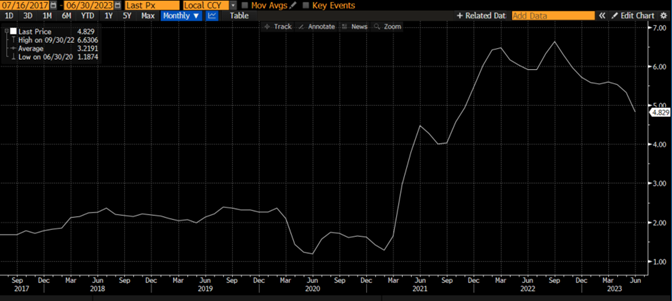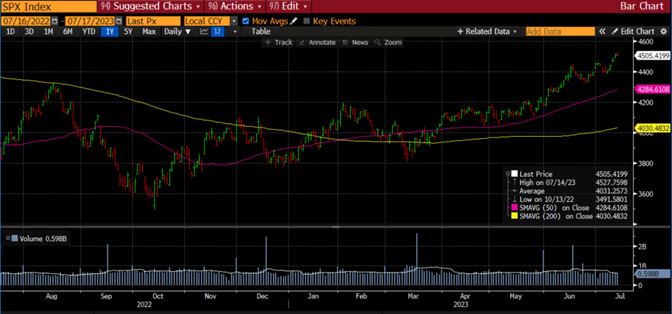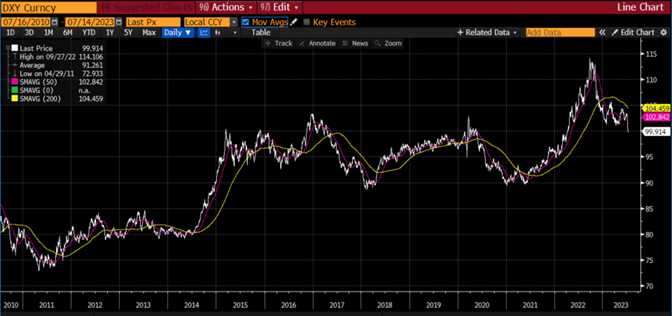Momentum — Week of July 17, 2023

Essential Economics
— Mark Frears
A Body in Motion
At an early age, I learned that bigger things don’t slow down, or change direction, quickly. On our barge at the cottage, with the 25 horsepower Evinrude engine, I quickly found out that the approach to the dock needed to start earlier than with the small aluminum boat. There are a few divots in the dock that provide evidence.
Momentum — or trends — in markets is closely watched as it can change over time, or sometimes before we can see it.
Inflation
Last week we had the Consumer Price Index (CPI) release. This is very closely watched as the impact of prices on consumers has far-reaching effects. As you can see below, the trend in CPI, excluding food and energy (known as core inflation) has been moving in the right direction.

The monthly change of 0.2% was the smallest since August 2021, almost two years. In the graph above, you can see the line getting steeper, gaining momentum. The overall CPI is down 6.1% in the last 12 months, the largest decline since 2009. While we are still not at the Fed’s goal of 2%, the speed of change has the market’s attention.
Equities
The S&P 500 Index has gained momentum over the last few months, surprising quite a few. The initial drive upwards was the effect of significant buying in technology stocks, especially Apple, Meta, Google, Microsoft, Nvidia and Amazon. The focus on Artificial Intelligence has ramped up attention on tech.
As you can see below, the spread between the 50- and 200-day moving averages is widening, as shown in the yellow and magenta lines. With more positive economic news and declining inflation expectations, more buyers are coming in to take part in this rally.

The concern for the longevity of this momentum is whether the current economic conditions will provide the earnings to justify these higher valuations.
USD
Another area that has seen a change in momentum is the foreign currency market. With declining inflation expectations comes lower bond yields, making the U.S. dollar (USD) currency less attractive versus other alternatives. As you can see below, the 200-day moving average (yellow line) has moved to a downward trend, and about to cross the 50-day moving average. From a technical viewpoint, this would accelerate the decline.

While this will make the U.S. exports more attractive to other countries, the lower U.S. Treasury (UST) yields will decrease money flows into the U.S., potentially making it harder for the Treasury to issue more debt.
Fed
Of course, we cannot leave the discussion of markets without considering the Fed. Their next meeting is on July 26 and the futures market has a 92% chance that they will hike the short-term Fed Funds (FF) rate by 25 basis points (bp).
They are sticking to their story that the inflation fight is not over. The momentum on the turning point for the direction of Fed rate moves is coming more into focus. With increasingly positive news on inflation, as seen in the CPI and Producer Price Index (PPI), as well as wages moderating, it could be time for a sustained pause. The market will be watching the verbiage in the press release and paying close attention to Chair Powell’s tone in the press conference for clues to the future.
The perception that a pause is coming has the markets anticipating this much desired change in momentum.
Economic releases
Last week we had the all-important inflation news, as outlined above. In addition, the UoM Consumer Sentiment came in well above expectations.
This week, we have retail sales, building permits, housing starts and industrial production. It will be interesting to see if the Leading Indicators improve, as markets are starting to bake in. See below for details.
Wrap-Up
“Nothing — absolutely nothing — is half so much worth doing as simply messing about in boats.” As stated in <em>The Wind in the Willows</em>, boats are a favorite place, and you must pay attention to the momentum — or speed. If you watch this, there will be benefits, same as in the markets.
| Upcoming Economic Releases: | Period | Expected | Previous | |
|---|---|---|---|---|
| 17-Jul | Empire Manufacturing | Jul | (3.5) | 6.6 |
| 18-Jul | Retail Sales MoM | Jun | 0.5% | 0.3% |
| 18-Jul | Retail Sales ex Autos MoM | Jun | 0.4% | 0.1% |
| 18-Jul | NY Fed Services Business Activity | Jul | N/A | (5.2) |
| 18-Jul | Industrial Production MoM | Jun | 0.0% | -0.2% |
| 18-Jul | Capacity Utilization | Jun | 79.5% | 79.6% |
| 18-Jul | Business Inventories | May | 0.2% | 0.2% |
| 18-Jul | NAHB Housing Market Index | Jul | 56 | 55 |
| 19-Jul | Building Permits | Jun | 1,490,000 | 1,491,000 |
| 19-Jul | Building Permits MoM | Jun | -0.4% | 5.2% |
| 19-Jul | Housing Starts | Jun | 1,475,000 | 1,631,000 |
| 19-Jul | Housing Starts MoM | Jun | -9.6% | 21.7% |
| 20-Jul | Initial Jobless Claims | 15-Jul | 241,000 | 237,000 |
| 20-Jul | Continuing Claims | 8-Jul | 1,730,000 | 1,729,000 |
| 20-Jul | Philadelphia Fed Business Outlook | Jul | (10.0) | (13.7) |
| 20-Jul | Existing Home Sales | Jun | 4,210,000 | 4,300,000 |
| 20-Jul | Existing Home Sales MoM | Jun | -2.2% | 0.2% |
| 20-Jul | Leading Index | Jun | -0.6% | -0.7% |
Mark Frears is an Investment Advisor, Executive Vice President, at Texas Capital Bank Private Wealth Advisors. He holds a Bachelor of Science from The University of Washington, and an MBA from University of Texas – Dallas.
The contents of this article are subject to the terms and conditions available here.